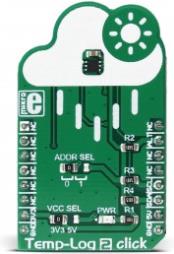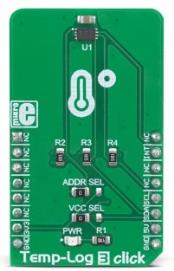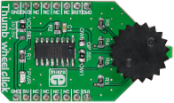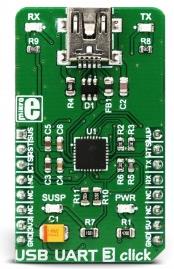Search
Search for "click":
(Click here to search this entire website for "click" with Google.)
 |

|
|
Temp-Log 2 click is a precise ambient temperature measurement device, equipped with the additional non-volatile (EEPROM) memory that can be used to permanently store system configuration, and 64 bits of general-purpose EEPROM, used for logging application specific or user preference data. This click covers a range of temperatures from -55°C to +125°C with the highest accuracy of ±0.2°C, in the range of -10°C to 85°C, exceeding the accuracy of CLASS A RTD. The device can also send an ALERT signal to the INT pin of the mikroBUS™ every time programmed temperature thresholds are exceeded. |
|
|
|
 |

|
|
Temp-Log 3 click is a temperature measuring Click board™ featuring the MCP9843 IC, an accurate temperature sensor IC with integrated EEPROM. Besides the thermal sensor, this IC is equipped with additional 256 bytes of EEPROM. This can be a very useful option for some applications: it allows any data to be stored within the same IC, so no additional EEPROM IC is required. This can simplify the design, reducing the number of additional components. The thermal sensor itself includes some great features such as the programmable interrupt engine, measurement range from -20°C to +125°C, accuracy up to ±1°C typically, and more.
Temp-Log 3 click is supported by a mikroSDK compliant library, which includes functions that simplify software development. This Click board™ comes as a fully tested product, ready to be used on a system equipped with the mikroBUS™ socket.
|
|
|
|
 |

|
|
Temp-Log 4 Click is a temperature measuring Click board™ featuring the SE97B IC, an accurate temperature sensor IC with integrated EEPROM. Besides the thermal sensor, this IC is equipped with additional 256 bytes of EEPROM, integrated on the same die. This can be a very useful option for some applications: it allows auxiliary data to be stored within the same IC, so no additional EEPROM IC is required. This can simplify the design greatly, reducing the number of required external components.
This Click board™ is supported by a mikroSDK compliant library, which includes functions that simplify software development. Temp-Log 4 click comes as a fully tested product, ready to be used on a system equipped with a mikroBUS™ socket.
|
|
|
|
 |

|
|
Temp-Log 5 click is a temperature measuring Click board™ featuring the CAT34TS02, an accurate temperature sensor IC with integrated Serial Presence Detect EEPROM. Temperature Sensor measures and store temperatures at least 10 times in second. Temperature measurement results can be retrieved by the host MCU via I2C interface, and are compared to critical limits stored into internal registers. It also features programmable event output function and supports three modes.
Temp-log 5 click is supported by a mikroSDK compliant library, which includes functions that simplify software development. This Click board™ comes as a fully tested product, ready to be used on a system equipped with the mikroBUS™ socket.
|
|
|
|
 |

|
|
Temp-Log 6 click is a temperature sensing Click board™, which features the MAX6642, a specifically designed IC, capable of measuring its own die temperature, as well as a temperature at a remote PN junction. This option makes Temp-Log 6 click well-suited for monitoring the temperature of a CPU, GPU or FPGA, where the PN junction is typically a substrate PNP transistor on the die of the measured IC. Instead of measuring the PN junction of a specifically designed IC, Temp-Log 6 click can also use an external diode or a small-signal transistor. The MAX6642 can also report an ALERT signal if programmed temperature thresholds are exceeded.
Temp-Log 6 click is supported by a mikroSDK compliant library, which includes functions that simplify software development. This Click board™ comes as a fully tested product, ready to be used on a system equipped with the mikroBUS™ socket.
|
|
|
|
 |

|
|
Thermostat click carries the MAX7502 IC digital temperature sensor, that also provides an overtemperature alarm/interrupt/shutdown output, and an SN74LVC1G126 single bus buffer from Texas Instruments. MAX7502 IC can measure temperatures from -25°C to +100°C, within the accuracy of ±1.5°C.
The G6D PCB power relay can control up to 5A, 250V AC/30V DC loads. |
|
|
|
 |

|
|
Thumbstick click is a high precision input device. It features a dual axis, spring return, pushbutton enabled joystick (similar to the ones used on joypads on popular gaming consoles), and a MCP3204 12-bit A/D converter. The joystick unit receives directional input in the x and y axes by way of two potentiometers connected to a stick. The mechanical pushbutton sends an interrupt signal to the microcontroller. Thumbstick click communicates with the target board through mikroBUS SPI (CS, SCK, MISO and MOSI) lines. The board is designed to use either a 3.3V or a 5V power supply (regulated by the on-board J1 jumper which is soldered to the 3.3V position by default). |
|
|
|
 |

|
|
Thumbwheel click is a mikroBUS add-on board with a 10-position rotary sprocket connected to a 1-Wire 8-Channel Addressable Switch. The starting position of the switch is marked with a small notch on the PCB above the wheel. Printed numerals from 1 to 10 clearly mark each position.
The thumbwheel has a crown with small incisions for better finger traction. The board can use both a 3.3V or a 5V power supply. The One-Wire signal can be sent either through the mikroBUS AN or PWM pins. You choose which one by soldering the GP SEL jumper into the right position. |
|
|
|
 |

|
|
USB UART 2 click provides USB isolation and carries the ADUM4160BRWZ USB port isolator. The click is designed to run on either 3.3V or 5V power supply. It communicates with the target microcontroller over UART interface, with additional functionality provided the following pins on the mikroBUS™ line: RST, CS, PWM, INT. |
|
|
|
 |

|
|
USB UART 3 click is a versatile and feature-rich USB to UART interface from Silicon Labs. It uses CP2102N which is a part of their USBXpress™ family. These devices are designed to quickly add a USB 2.0 full-speed compliant UART interface for custom applications, by eliminating firmware complexity and reducing development time. The Click board™ requires appropriate drivers to be installed in the host OS, in order to support the virtual COM port functionality. Once installed, this device offers amazing connectivity options, up to 3 Mbaud, a very low number of external components, simplified setup of the advanced options via the GUI-based configurator (if required), out-of-the-box functionality with the royalty-free virtual COM port drivers, provided by the Silicon Labs. |
|
|
|
 |
|
<< First
< Previous
Next >
|
|

